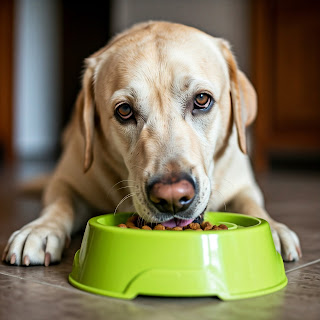Why Do Dogs Eat Too Fast?
Several factors can contribute to rapid eating in dogs:
- Competition: In multi-dog households, dogs may feel the need to eat quickly to prevent others from stealing their food.
- Instinct: Dogs in the wild often had to compete for food, leading to an instinct to eat as much as possible as quickly as possible.
- Boredom or Anxiety: Some dogs may eat quickly out of boredom or anxiety.
- Previous Scarcity: Dogs who have experienced food scarcity in the past may develop a habit of rapid eating.
- Food Type: Dry kibble can be easier to gulp down quickly compared to wet food.
The Dangers of Fast Eating
Rapid eating can lead to several health problems in dogs: - Bloat (Gastric Dilatation-Volvulus): This is a serious, life-threatening condition where the stomach fills with gas and can twist, cutting off blood supply. Large breed dogs are particularly susceptible.
- Vomiting and Regurgitation: Eating too quickly can overwhelm the digestive system, leading to vomiting or regurgitation.
- Choking: Gulping down large amounts of food can increase the risk of choking.
- Poor Nutrient Absorption: When food is eaten too quickly, the body may not have enough time to properly absorb nutrients.
- Weight Gain: Eating rapidly can lead to overeating and weight gain, which can contribute to other health problems like joint issues and diabetes.
How Do Slow Feeder Dog Bowls Work?
Slow feeder dog bowls are designed to physically slow down a dog's eating. They achieve this through various design elements:- Obstacles and Patterns: Many slow feeders feature raised patterns, spirals, or obstacles within the bowl. These force the dog to navigate around the obstacles to access their food, slowing down their eating pace.
- Separate Compartments: Some bowls have multiple small compartments, requiring the dog to eat from each compartment individually.
- Different Depths and Shapes: Variations in depth and shape within the bowl can also slow down eating.
Types of Slow Feeder Dog Bowls
There are several types of slow feeder dog bowls available:- Puzzle Bowls: These bowls present a more challenging eating experience, often requiring the dog to move or manipulate parts of the bowl to access the food. These are also known as interactive slow feeder dog bowls.
- Spiral Bowls: These feature a spiral pattern in the center of the bowl, forcing the dog to eat around the spiral.
- Compartment Bowls: These bowls have multiple small compartments that hold food, requiring the dog to eat from each compartment individually.
- Raised or Elevated Slow Feeders: These combine the benefits of an elevated bowl with the slow feeding design, promoting better digestion and reducing strain on the neck and joints, especially beneficial for larger dogs.
- Mats and Inserts: These are designed to be placed inside a regular dog bowl, creating obstacles that slow down eating.
Materials
Slow feeder dog bowls are made from various materials:- Plastic: Affordable and lightweight, but some plastics may not be as durable or easy to clean.
- Stainless Steel: Durable, hygienic, and easy to clean, but can be more expensive. This is often seen in best slow feeder dog bowl options.
- Ceramic: Attractive and easy to clean, but can be fragile and prone to chipping.
Do Slow Feeder Dog Bowls Really Work?
The short answer is yes, slow feeder dog bowls can be very effective in slowing down eating. Studies and anecdotal evidence show that they can significantly reduce eating speed, which can help prevent the health problems associated with rapid eating. These are often considered the best slow feeder dog bowl for fast eaters.
Choosing the Right Slow Feeder Dog Bowl
When choosing a slow feeder dog bowl, consider the following factors:- Dog's Size and Breed: Choose a bowl that is appropriately sized for your dog. Larger breeds will need larger bowls with deeper compartments or larger obstacles.
- Dog's Eating Style: Some dogs may be more determined to eat quickly and may require a more challenging bowl.
- Material: Consider the durability, hygiene, and ease of cleaning of the material. Stainless steel slow feeder dog bowl options are generally considered a good choice.
- Ease of Cleaning: Choose a bowl that is easy to clean and dishwasher safe if possible.
- Stability: The bowl should be stable enough to prevent tipping, especially for larger dogs.
- Durability: Choose a bowl that is made from durable materials that can withstand regular use.
Introducing a Slow Feeder Bowl
-
Introduce the bowl gradually: Let your dog sniff and explore the new bowl before using it for feeding.
- Start with small meals: Begin by feeding smaller meals in the slow feeder bowl to allow your dog to adjust.
- Monitor your dog's progress: Observe your dog's eating habits and adjust the bowl or feeding strategy as needed.
- Positive reinforcement: Use positive reinforcement, such as praise and treats, to encourage your dog to use the new bowl.
Cleaning and Maintenance
Regular cleaning is essential to prevent bacterial growth. Wash the bowl regularly with warm soapy water and rinse thoroughly. Some bowls are dishwasher safe, but check the manufacturer's instructions.
Conclusion
Slow feeder dog bowls are a valuable tool for promoting healthy eating habits in dogs. They can effectively slow down eating, reducing the risk of bloat, vomiting, choking, and other health problems. By considering the different types, materials, and features available, you can choose the best slow feeder dog bowl for your furry friend and help them enjoy healthier, more relaxed mealtimes. Whether you’re looking for a stainless steel slow feeder dog bowl, an interactive slow feeder dog bowl, or a simple plastic option, there’s a solution available to help your dog eat at a healthier pace. 


0 Comments